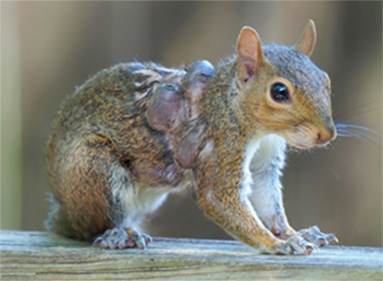If you’ve ever shot a squirrel or rabbit with one or more nasty, hairless lumps on its body then you’ve likely dealt with the botfly larvae.
Nasty is one way to describe it, for sure. They’re nightmarish just looking at photos of them.
Knocking down a squirrel or rabbit and then grabbing it without seeing the larvae lump can make your guts churn. Especially if the lump is wriggling and writhing since the squirrel or rabbit has died.

Back when I was a kid starting out squirrel hunting on my own, my father would recommend waiting until after a hard frost. One reason was because here in Alabama it’s danged hot and humid late in autumn. Our winter isn’t really winter until December, it seems, so trying to hunt squirrels in the early part of the season is hot, humid and not as enjoyable. Plus, we still have a ton of leaves on the trees. Finding a squirrel in a leafy oak can be challenging.

The other reason was because the hard frost and cold temperatures, especially if they were prolonged, would kill the wolves. I didn’t know what wolves were until he explained it. His explanation wasn’t scientific either; best I can recall, “some kind of fly” laid an egg and it hatched. That was more than 35 years ago, though, so my memory isn’t great on the specifics of what he said.
All I can remember is wolves looked nasty on squirrels or rabbits, I didn’t want to touch the animals, and I darn sure didn’t want to eat anything that had lumpy tumors on its body. The wolves on rabbits always seemed to look worse than on the squirrels, too. I’m unsure why I thought that, but I always did. Perhaps it’s because I believe rabbits are wimpier than gray and fox squirrels.
Related: How to Skin and Process a Rabbit
See the video below from SC Things of a gray squirrel afflicted with these warbles:
What Is a Botfly?
Botflies look like a bumblebee with a weight problem or a hairy housefly in desert camo with an addiction to the weight room in the local gym.
With squat bodies, yellow-black markings and giant eyes, they definitely cut an imposing figure. As noted, some people call them wolves or warbles. They also are known as warble flies, heel flies, gadflies and maybe some other names. The larvae of these flies is parasitic; the botfly will use a housefly or mosquito to transfer its eggs to the animal or human host.

Deer Botfly, which lays eggs that hatch in a deer’s nasal cavity where the larvae grow in the warm, moist conditions. (Photo: Wiki, Karsten Heinrich)
There, things get nasty. Botfly larvae live under the skin or in a host’s digestive tract. In whitetail deer, the botfly’s eggs hatch and the larvae then take up residence in the nasal cavity. Hunters who have killed deer and then found giant larvae wriggling in their nose or throats when cutting out a jawbone can attest to the squeamish factor.
Once hatched, the larvae feed on the host until grown and then exit the host to the soil. There, their life cycle continues and repeats. In domestic animals and humans, infections can be treated. In wild animals, such as squirrels, rabbits and deer, well, they’re on their own. If the animal dies the botfly larvae will begin to exit since its host is no longer capable of being a host.

Related: Deer-Urine Prank at Walmart, the Lingering Odor and the Magic of the Tarsal Gland
Are botfly harmful to you if you grab a squirrel or rabbit that is a host? No. They aren’t going to slither up your wrists and into your blood vessels. You’re not going to catch the Ickyootie Disease by touching the squirrel or rabbit. And chances are if you’ve ever shot a deer, cleaned it quickly and didn’t poke around it’s head or mouth then you maybe didn’t even know they were there.

But I wouldn’t eat a squirrel or rabbit with botfly larvae. The meat might be fine. I’m not hungry enough to do so, though. I’d just chalk it up to being part of my bag limit and hope for another bushytail or cottontail for my game vest.

If you want to see what happens with botfly larvae once the host dies, watch the video below from Travel for Wildlife. It’s, um, interesting